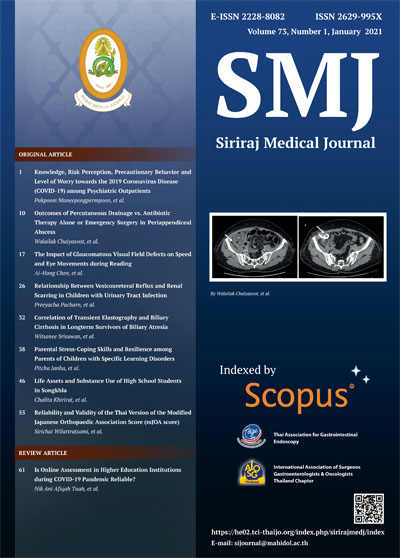Relationship Between Vesicoureteral Reflux and Renal Scarring in Children with Urinary Tract Infection
DOI:
https://doi.org/10.33192/Smj.2021.04Keywords:
Vesicoureteral reflux, VUR, renal scar, urinary tract infection, UTIAbstract
Objective: To evaluate the association of vesicoureteral reflux (VUR) in comparison with the development of renal scarring in child patients with urinary tract infection (UTI).
Methods: This study involved a retrospective review. Patients under 14 years old with a diagnosis of UTI with a positive urine culture and who had a voiding cystourethrogram (VCUG) and technetium 99 m dimercaptosuccinic acid (Tc-99m_DMSA) renal scintigraphy performed within 4-6 months after acute UTI were included in the study. The VCUG results were classified as positive or negative for vesicoureteral reflux (VUR). If reflux was present, the severity was graded according to the recommendation of the International Reflux Study in children.1 The Tc-99m DMSA results were interpreted as positive or negative for renal scarring. Statistical analysis was performed using the χ2 test or Fisher’s exact test and Mann–Whitney test to compare the presence of VUR and renal scarring as well as the grading of the VUR and renal scarring. Positive and negative likelihood ratios (LR) were calculated.
Results: In total, 185 patients (74 girls and 111 boys; mean age, 3.5 years old) were included in the study. There were five children with only a single kidney, resulting in 365 kidneys for analysis. Vesicoureteral reflux was found in 203 (55.6%) kidneys, classified as grades 1, 2, 3, 4, and 5 in 19, 31, 81, 38, and 34 kidneys, respectively. Scarring was found in 110 of 203 kidneys (54.2%) with VUR and in 18 of 162 kidneys (11.1%) without VUR (p < 0.0001). The LR positive was 2.2 (95%CI, 1.9–2.5) and LR negative was 0.23 (95% CI, 0.1-0.4).
Conclusion: There was a significant correlation between positive VUR and the development of renal scarring. Patients with positive VUR should be considered for a Tc99m-DMSA scan to evaluate them for the development of renal scarring.
Published
How to Cite
Issue
Section
License

This work is licensed under a Creative Commons Attribution-NonCommercial-NoDerivatives 4.0 International License.
Authors who publish with this journal agree to the following conditions:
Copyright Transfer
In submitting a manuscript, the authors acknowledge that the work will become the copyrighted property of Siriraj Medical Journal upon publication.
License
Articles are licensed under a Creative Commons Attribution-NonCommercial-NoDerivatives 4.0 International License (CC BY-NC-ND 4.0). This license allows for the sharing of the work for non-commercial purposes with proper attribution to the authors and the journal. However, it does not permit modifications or the creation of derivative works.
Sharing and Access
Authors are encouraged to share their article on their personal or institutional websites and through other non-commercial platforms. Doing so can increase readership and citations.















